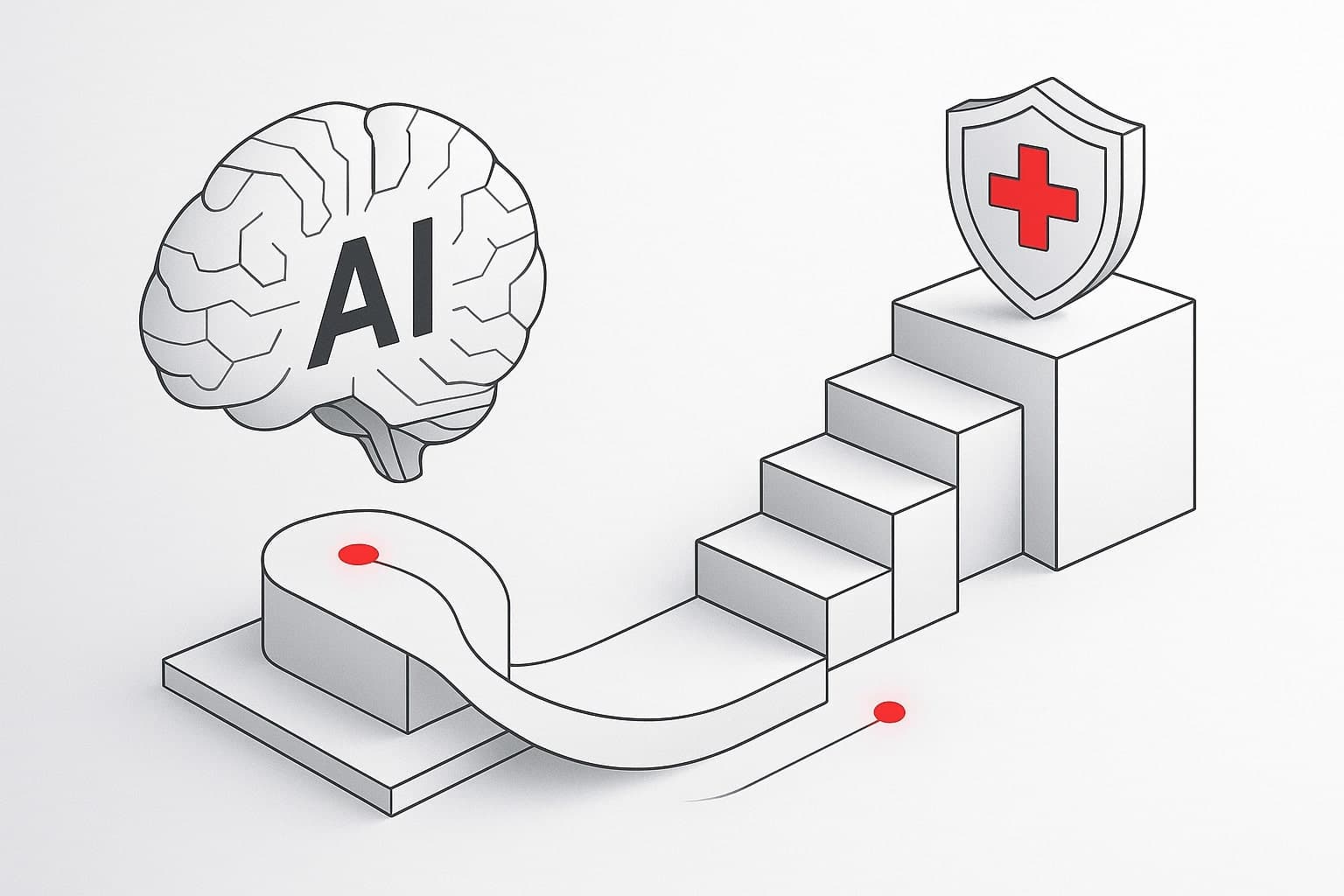October 14, 2025
Healthcare

Healthcare is evolving — and AI is at the center of it. From faster diagnostics to predictive care and smarter resource allocation, Artificial Intelligence is helping healthcare providers make better, faster, and more accurate decisions.
But for most clinics and hospitals, the biggest challenge isn’t understanding what AI can do — it’s knowing where to begin.
If you’ve been wondering how to launch your AI journey in healthcare, this guide will walk you through a clear, practical roadmap — helping you go from concept to deployment confidently, safely, and strategically.
Before investing in technology, start with strategy. AI is a tool — not a goal. The key is identifying how it supports your hospital’s or clinic’s mission.
Ask the Right Questions:
Which challenges can AI realistically solve for us?
What processes are consuming the most time or resources?
Are we looking to improve patient outcomes, reduce costs, or streamline operations?
Examples of AI Goals in Healthcare:
Automating patient intake and triage.
Reducing diagnostic errors using imaging analysis.
Predicting patient readmission risks.
Optimizing staff scheduling or inventory management.
Tip: Start with one focused use case that has measurable ROI potential and expand as you gain confidence.
AI runs on data, and healthcare data is often complex, fragmented, and sensitive. Before implementing any AI system, evaluate your data infrastructure and governance maturity.
Checklist for Data Readiness:
Data is stored digitally and accessible across departments.
Records are standardized (EHR, lab data, imaging, billing).
Data privacy and consent protocols meet HIPAA or local regulations.
There’s a secure storage and backup mechanism in place.
Example: A clinic planning to deploy an AI triage chatbot discovered its patient data was spread across three systems — forcing a six-week data consolidation phase before integration.
Pro Tip: Partnering with an AI consulting firm experienced in healthcare ensures compliance and proper data handling from the start.
Not every process needs automation. Focus on AI use cases that deliver tangible benefits and align with your organization’s priorities.
Popular AI Use Cases in Healthcare:
Diagnostics: AI-powered radiology image analysis for early disease detection.
Operations: Predictive analytics for resource allocation and scheduling.
Patient Engagement: Chatbots for appointment booking, follow-ups, and FAQs.
Clinical Decision Support: AI tools that assist physicians with treatment recommendations.
Revenue Cycle Management: Automating coding, billing, and claims.
Mini Case Study:
A mid-sized hospital introduced an AI-based appointment prediction system to reduce no-shows. Within three months, appointment adherence increased by 22%, and administrative workload dropped by 30%.
AI adoption requires the right blend of technical and domain expertise. Most healthcare providers don’t need to build full in-house AI teams right away — strategic partnerships can accelerate outcomes.
Options to Consider:
Internal Team Setup: Data engineers, ML developers, and compliance officers.
Partnership Model: Work with an AI agency specializing in healthcare automation and analytics.
Hybrid Approach: Use internal clinical knowledge + external technical expertise.
Example: A healthcare network partnered with an AI automation agency to implement a predictive triage model — reducing patient backlog by 25% without hiring new data scientists.
Your infrastructure determines scalability and security. Choose a setup that matches your organization’s size, budget, and compliance requirements.
Infrastructure Options:
Cloud-Based AI: Scalable and cost-effective (e.g., AWS HealthLake, Azure Health Data Services).
On-Premise AI: For institutions with strict data privacy mandates.
Hybrid Models: Balance between local control and cloud flexibility.
Considerations:
Data storage and transfer encryption.
Integration with existing EHR/EMR systems.
Vendor compliance certifications (HIPAA, ISO 27001, GDPR).
Rather than attempting a massive rollout, start with a pilot project. This helps identify technical and operational challenges early.
Pilot Phase Goals:
Test one AI use case (e.g., readmission prediction, chatbot support).
Collect feedback from clinicians and staff.
Measure outcomes using clear KPIs — accuracy, time saved, cost reduction, etc.
Example:
A 200-bed hospital piloted an AI-based readmission prediction tool in one department. After 4 months, it achieved 87% prediction accuracy and reduced readmissions by 14%. The success led to a network-wide rollout.
Healthcare AI must meet the highest standards of safety, privacy, and transparency. Compliance isn’t an afterthought — it’s integral to trust.
Key Steps:
Implement HIPAA/GDPR-compliant data handling.
Maintain audit trails for all AI-driven decisions.
Set up bias and fairness checks in model validation.
Ensure explainability — clinicians should understand how AI arrives at recommendations.
Note: A transparent AI system improves clinician trust and patient acceptance, reducing adoption resistance.
AI is only as effective as the people who use it. Encourage adoption through education, workshops, and communication.
Training Essentials:
Educate staff about AI’s role and limitations.
Provide simulation-based learning for clinicians.
Highlight real benefits: time savings, better outcomes, reduced burnout.
Example:
A clinic introduced AI-driven transcription software and conducted 3 short training sessions. Within two weeks, doctors reported 40% less administrative burden.
AI systems are not “set-and-forget.” Continuous monitoring ensures sustained performance and compliance.
Best Practices:
Set regular model audits for accuracy and bias.
Gather end-user feedback to refine workflows.
Expand to additional departments or functions gradually.
Example:
A hospital that began with AI-powered scheduling expanded its solution to include predictive staffing — saving 20% in overtime costs.
Skipping data preparation: Poor data = poor AI outcomes.
Choosing tech before strategy: Always define goals first.
Underestimating training needs: Users must understand AI tools.
Ignoring compliance: Fines and trust loss can outweigh benefits.
Starting your AI journey in healthcare doesn’t require massive budgets or technical teams — it requires clarity, vision, and the right partnerships.
Whether you’re a clinic looking to improve patient care or a hospital aiming to streamline operations, AI can amplify your capabilities and unlock long-term efficiency.
At MLab Innovations, we help healthcare providers design, implement, and scale AI solutions — responsibly and affordably.
Start your AI journey today — and make smarter, data-driven care your competitive advantage.